With the Columbia accident investigation largely complete, workers at the Kennedy Space Center have begun packing up the 84,000 pieces of debris from the disaster. Unlike the debris from Challenger, which was packed away into two abandoned missile silos after the 1986 disaster, the material from Columbia will probably be made available for research. It may also show up in the Smithsonian Air and Space Museum in Washington, but NASA hasn’t decided if it’s appropriate or not. Officials expect to have the hanger clear of debris by the end of September.
NASA Proposes to Search for Smaller Asteroids
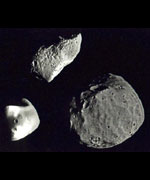
Image credit: NASA/JPL
Five years ago NASA began a program to discover 90% of potential Earth-crossing asteroids larger than 1 km. 60% of the 1,000 to 1,200 large Near Earth Asteroids have already been found, and the search should be complete by 2008. But objects below 1 km can still be devastating, so NASA is proposing a new survey to track hundreds of thousands of these smaller objects. The new report proposes that NASA spend $236 million over the course of 20 years to find 90% of these smaller, but still devastating, objects. Another option would be to build a space-based tracking system which would increase the cost to $397 million but cut the search time down to just seven years.
NASA has released a technical report on potential future search efforts for near-Earth objects after a year of analysis by scientists working on this issue. This Science Definition Team was chartered to study what should be done to find near-Earth objects less than 1 kilometer in size. While impacts by these smaller objects would not be expected to cause global devastation, impacts on land and the tsunamis resulting from ocean impacts could still cause massive regional damage and still pose a significant long-term hazard.
In 1998 NASA commenced its part of the “Spaceguard” effort, with the goal of discovering and tracking over 90% of the near-Earth objects larger than one kilometer by the end of 2008. An Earth impact by one of these relatively large objects would be expected to have global consequences and, over time scales of a few million years, they present the greatest impact hazard to Earth. Approximately 60% of the estimated 1,000 to 1,200 large near-Earth objects have already been discovered, about 45% since NASA efforts started, and each of the five NASA-supported search facilities continue to improve their performance, so there has been good progress toward eliminating the risk of any large, undetected impactor.
To understand the next steps to discovering the population of potentially hazardous asteroids and comets whose orbits can bring them into the Earth’s neighborhood, NASA turned to this Science Definition Team of 12 scientists. The Team, chaired by Dr. Grant Stokes of the MIT Lincoln Laboratory, was asked to study the feasibility of extending the search effort to the far more numerous, perhaps hundreds of thousands, of near-Earth objects whose diameters are less than one kilometer.
NASA considers the Science Definition Team’s findings to be preliminary, and a much more in-depth program definition, refining objectives and estimating costs, would need to be conducted prior to any decision to continue Spaceguard projects beyond the current effort to 2008.
Original Source: NASA News Release
Satellites Help Forecasters Predict Hurricanes
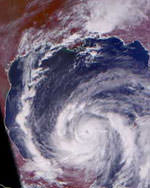
Image credit: NASA
Weather forecasters are turning to data from a fleet of satellites to help predict how conditions might turn into hurricanes that could ravage the coastal areas of Eastern North America. Tropical storms typically appear off the coast of Africa from June to November; some of these will turn into hurricanes depending on many factors. Satellites can now spot many of the warning signs, including a sea surface temperature of at least 27.8 degrees Celsius, rotating winds above the ocean, air temperature, humidity, and finally rainfall intensity.
Every year, from June 1 to November 30, the Atlantic Ocean becomes a meteorological mixing bowl, replete with all the needed ingredients for a hurricane recipe. Forecasters who seek to monitor and understand hurricanes are increasingly turning to a cadre of NASA satellites and instruments, including several from NASA’s Jet Propulsion Laboratory, Pasadena, Calif., that serve up a feast of information on these awesome storms.
Typically, during the peak of hurricane season, from late August to mid-September, tropical cyclones of interest to U.S. coastal regions form around the Cape Verde Islands off Africa. NASA satellites are critical for helping forecasters determine if all of the ingredients are coming together to create a hurricane. If a hurricane forms, it is critical to know how strong it may be, and which coastal communities or sea lanes will be at risk.
NASA provides researchers and forecasters with space-based observations, data assimilation and computer climate modeling. NASA-sponsored measurements and modeling of global sea surface temperature, precipitation, winds and sea surface height have also improved understanding of El Ni?o and La Ni?a events, which respectively tend to suppress and enhance Atlantic and Gulf hurricane development.
Thirty years ago, meteorologists were unable to see the factors in hurricane formation and could only spot a hurricane with still pictures from the Television Infrared Operational Satellite – Next-generation (Tiros-N) spacecraft. Over the past 10 years, visible and infrared satellite sensors were the workhorses for monitoring hurricanes. Today, multiple NASA satellites exploit everything from radar pulses to microwaves for the purpose of enhancing forecasts, providing data to researchers several times a day.
The first ingredient in the hurricane recipe is a sea surface temperature of at least 27.8 degrees Celsius (82 degrees Fahrenheit). Unlike traditional infrared satellite instruments, the Aqua satellite’s Advanced Microwave Scanning Radiometer E and the Tropical Rainfall Measuring Mission’s microwave imager can detect sea surface temperatures through clouds. This valuable information can help determine if a tropical cyclone is likely to strengthen or weaken. The joint U.S.-French Jason-1 satellite altimeter, managed by JPL, provides data on sea surface height, a key measurement of ocean energy available to encourage and sustain hurricanes.
Another necessary ingredient is rotating winds over the ocean’s surface, precursors to tropical cyclone development. The NASA-provided and JPL-built and managed SeaWinds instruments aboard Japan’s Midori 2, and NASA’s Quick Scatterometer (QuikScat) satellites can detect these winds before other instruments, providing even earlier notice of developing storms to forecasters and scientists.
Air temperature and humidity are also important factors. The JPL-managed Atmospheric Infrared Sounder experiment suite aboard the Aqua satellite obtains measurements of global temperature and humidity throughout the atmosphere. This may lead to improved weather forecasts, improved determination of cyclone intensity, location and tracks, and the severe weather associated with storms, such as damaging winds.
Rainfall intensity is the final ingredient, and the precipitation radar provided by Japan for the Tropical Rainfall Measuring Mission satellite provides computed tomography (CAT) scan-like views of rainfall in the massive thunderstorms of hurricanes. The mission’s instruments probe young tropical systems for rainfall intensity and the likelihood of storm development. The mission also sees “hot towers” or vertical columns of rapidly rising air that indicate very strong thunderstorms. These towers are like powerful pistons that convert energy from water vapor into a powerful wind- and rain-producing engine. Once a storm develops, the mission provides an inside view of how organized and tightly spiraled rain bands are, key indicators of storm intensity.
The Tropical Rainfall Measuring Mission provides tropical cyclone intensity information from the safe distance of space, allowing the National Oceanic and Atmospheric Administration’s National Hurricane Center and the Department of Defense Joint Typhoon Warning Center to turn to it, QuikScat and other NASA satellites for early assessment of storms in the open ocean.
The hurricane monitoring capabilities enabled by these satellites are funded by NASA’s Earth Science Enterprise, which is dedicated to understanding Earth as an integrated system and applying Earth system science to improve prediction of climate, weather and natural hazards using the unique vantage point of space.
Original Source: NASA/JPL News Release. Here are some hurricanes pictures.
NASA Approves Mirror for James Webb Telescope
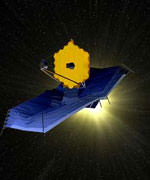
Image credit: NASA
NASA announced today that it has selected a beryllium-based mirror technology for the 6.5 mirror on the James Webb Space Telescope – the successor to the Hubble Space Telescope. The primary mirror will actually be made up of 18 hexagonal-shaped segments, giving it 2.5 times more surface area than Hubble’s mirror; but it will be one-third the weight. Construction of the mirror will begin next year, and the telescope is expected to launch some time after 2011.
NASA today announced a major milestone in the development of the James Webb Space Telescope (JWST), the selection of a beryllium-based mirror technology for the telescope’s 6.5-meter primary mirror.
The JWST prime contractor, Northrop Grumman, Redondo Beach, Calif., recommended that NASA select the mirror technology, supplied by Ball Aerospace & Technologies Corporation, Boulder, Colo., for the JWST primary mirror.
Northrop Grumman made the recommendation following a detailed process that took advantage of insights from a panel of experts representing the contractor team, NASA and the science community. Two mirror technologies, beryllium and ultra low-expansion glass, were tested, and their implementation plans were thoroughly reviewed during a six-month evaluation. Technical performance, manufacturing schedule, facilities, staffing, and cost were factors taken into consideration.
The production of the beryllium-based mirrors will begin within the next year. The mirrors will be incorporated into optical assemblies, mounted on the telescope structure, and subjected to a series of tests at cryogenic temperatures, individually and as an integrated system.
The Observatory design features a 6.5-meter aperture primary mirror, comprised of 18 hexagonal shaped segments. The telescope will be 2.5 times the diameter, yet weigh only one-third as much, as the mirror on the Hubble Space Telescope. JWST will be orders of magnitude more sensitive than ground-based infrared telescopes.
After launch in 2011, JWST will peer into the infrared at great distances to see the first stars and galaxies formed in the universe billions of years ago. A flagship mission in NASA’s Origins Program, JWST will search for answers to astronomers’ fundamental questions about the birth and evolution of galaxies, the size and shape of the universe, and the mysterious life cycle of matter.
NASA’s Goddard Space Flight Center, Greenbelt, Md., manages the JWST project for NASA Headquarters’ Office of Space Science, Washington. The project consists of an international team involving NASA, the European Space Agency, Canadian Space Agency, industry and academia.
Northrop Grumman is prime contractor leading a team including Ball Aerospace, Eastman Kodak Company, Rochester, N.Y.; and Alliant Techsystems, Magna, Utah. The major beryllium mirror subcontractors to Ball Aerospace are Tinsley Laboratories, Richmond, Calif.; Axsys Technologies, Cullman, Ala.; and Brush Wellman Inc., Elmore, Ohio.
Original Source: NASA News Release
Titan Launches Secret Satellite
The US Air Force launched a secret satellite cargo early Tuesday morning on board a Titan IV-B rocket. The satellite is believed to be an Advanced ORION signals intelligence satellite for the National Reconnaissance Office. The Air Force was so secretive about the launch that they were unwilling to release information about its costs, purpose, or even who built it.
Electrons Surfing on a Solar Wind
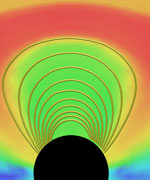
Image credit: NASA
New research indicates that electrons may surf on magnetic waves driven by the solar wind, and get accelerated to the point they can cause some serious damage to spacecraft orbiting the Earth. The process is a result of the interaction between the Earth’s magnetic field and fluctuations in the density of the solar wind. As the density of the solar wind changes, it causes waves in the magnetic field to ripple back to the Earth. Electrons can be caught in these ripples and surf back to the Earth so fast they can damage delicate electronics in space.
“Killer” electrons capable of wreaking havoc on orbiting spacecraft may “surf” magnetic waves driven by the solar wind, according to a team of space scientists.
The team from Boston University and the National Oceanic and Atmospheric Administration (NOAA) combined observations from NASA and NOAA spacecraft to identify a phenomenon that explains how the solar wind makes waves in Earth’s magnetic field (magnetosphere). Ordinary electrons orbiting the Earth in the Van Allen radiation belts may boogyboard the waves, accelerating to near the speed of light, with energies 300-500 times greater than the electrons in a television screen.
The solar wind is a stream of electrically charged particles blown constantly from the Sun. The magnetosphere is a cavity formed when the solar wind encounters the Earth’s magnetic field. When the solar wind density is high and comes up against the magnetosphere, the magnetosphere gets compressed. When the wind density is low, the magnetosphere expands. The researchers discovered that the solar wind contains periodic structures of high and low density, driving a periodic “breathing” action of the magnetosphere and the global generation of magnetic waves.
It’s known that if the frequency of these waves matches the frequency of the electrons in their motion in the Van Allen belt, the electrons can be accelerated, significantly boosting their energies. The process is similar to a boogyboarder catching a wave. Some electrons “ride the wave” and gain so much energy that they can then damage expensive spacecraft.
“If we can confirm this as a significant mechanism for making the waves that accelerate ‘killer’ electrons, then scientists using data from satellites like Wind could develop advance warning for spacecraft operators that their spacecraft may be in danger of excessive and damaging radiation exposure,” said Dr. Barbara Giles, project scientist for the Polar spacecraft at NASA’s Goddard Space Flight Center, Greenbelt, Md.
When electrons become this energetic, they can penetrate to the interior of spacecraft. Once inside electronic parts, they build up static electricity that can short circuit a critical part or put the spacecraft into a bad operating mode.
“What’s new and exciting about this research is that people had always looked for mechanisms internal to the magnetosphere for generating these waves,” said Dr. Larry Kepko, research associate at Boston University and lead author of two papers on this research, one published in the Journal of Geophysical Research in June 2003 and the other in Geophysical Research Letters in 2002. “But here we’ve found an external mechanism – the solar wind itself.”
NASA’s Polar and Wind satellites, along with NOAA’s Geostationary Operational Environmental Satellite (GOES), provided the key observations leading the team to this conclusion. Polar confirmed that the waves are not local, but global. The Wind satellite was the primary source for identifying the density structures in the solar wind that drive the magnetosphere. GOES provided data about the Earth’s magnetosphere as it increased and decreased in size.
“We already knew that the solar wind has density structures and that magnetic waves can accelerate electrons,” said Dr. Harlan Spence, associate professor of astronomy at Boston University and co-author of the two papers on this research. “What we didn’t know was that the solar wind structures can be periodic and drive magnetic waves. These new observations may provide a missing link between the two.”
The ultimate source of these newly discovered solar wind structures is still a mystery, but the team speculates that the Sun may play a direct role. “The solar wind density variations are partly controlled by the pattern of magnetic reconnection, the twisting and snapping of magnetic field lines, on the surface of the Sun,” says Dr. Kepko. “Reconnection occurring in a systematic, periodic manner may produce the observed periodic density structures in the solar wind. There is some evidence that this may be occurring, but further research is required to establish a definitive link.”
The Van Allen radiation belts were discovered in 1958 by Dr. James Van Allen and his team at the University of Iowa with Explorers 1 and 3, the first satellites successfully launched by the United States. They are belts of electrically charged particles trapped by the Earth’s magnetic field. Since the particles are electrically charged (mostly protons and electrons), they feel magnetic forces and are constrained to spiral around invisible lines of magnetic force that comprise the Earth’s magnetic field. There are actually two donut-shaped belts in the Van Allen system, one inside the other with the Earth in the “hole” of the inner belt. The inner belt, made up of high-speed protons, is located at altitudes between 430 and 7,500 miles (about 700 to 12,000 km) above the Earth. The outer belt is made of high-speed electrons and appears at altitudes between 15,500 and 25,000 miles (about 25,000 to 40,000 km) above Earth. Spacecraft operators try to avoid orbits in these regions, but sometimes these altitudes are best for a particular mission, or the spacecraft must pass through the belts during part of its orbit or to escape the Earth entirely.
NASA’s Polar and Wind satellites, together known as the “Global Geospace Science Program,” are dedicated to helping scientists understand how particles and energy from the Sun flow through, and interact with, the Earth’s space environment.
NOAA is dedicated to gathering data about the oceans, the atmosphere, space, and the Sun. Its GOES satellite system is the basic element for U.S. weather monitoring and forecasting. Dr. Howard Singer from NOAA is a third co-author on the 2002 paper about this research.
Original Source: NASA News Release
Sunlight Spins Asteroids
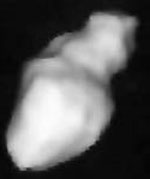
Image credit: NASA/JPL
Astronomers have long-held that collisions were the primary cause of spinning asteroids, but new research indicates that it might be something much more gentle: sunlight. In a recent study carried out by the Southwest Research Institute (SwRI) and Charles University (Prague), astronomers calculated the effect of millions and even billions of years of sunlight pressure can cause an asteroid to spin so fast it can fly apart; others can be made to stop spinning completely.
A new study by researchers at Southwest Research Institute (SwRI) and Charles University (Prague) has found that sunlight can have surprisingly important effects on the spins of small asteroids. The study indicates that sunlight may play a more important role in determining asteroid spin rates than collisions, which were previously thought to control asteroid spin rates. Results will be published in the Sept. 11 issue of Nature.
David Vokrouhlicky (Charles University), David Nesvorny and William Bottke (both of the SwRI Space Studies Department) conducted the study, which showed that sunlight absorbed and reemitted over millions to billions of years can spin some asteroids so fast they could potentially break apart. In other cases, it can nearly stop them from spinning altogether. The team even noted that the effects of sunlight, combined with the gravitational tugs of the planets, can slowly force asteroid rotation poles to point in the same direction.
Until recently, researchers thought asteroid impacts controlled the rotation speed and direction of small asteroids floating in space. The unusual spin states of 10 asteroids observed by Stephen Slivan, a researcher at the Massachusetts Institute of Technology, however, have cast doubt on this idea. Slivan’s asteroids, the first in the 15- to 25-mile-diameter range to have their spins extensively studied, are in the so-called Koronis asteroid family, a cluster of asteroid fragments produced by a highly energetic collision billions of years ago. Slivan found that not only do four of these asteroids rotate at nearly the same speed, but they also have spin axes that point in the same direction.
“The data clearly show that the spin vector alignment is real, but how they got that way has been a big puzzle,” says Slivan. “I’m delighted that others find this to be an interesting problem.”
“To picture just how weird these asteroids really are, imagine you were handed a box of spinning tops just as you were about to launch aboard the space shuttle. Given all the shaking produced by the launch, you would expect the tops to have different spin speeds and orientations by the time you reached orbit,” says Bottke. “Instead, imagine your surprise upon opening the box if the tops were all spinning at the same speed and had their handles pointing toward the constellation Cassiopeia. Now increase the size of the tops by a factor of a million and pretend that the bouncing during launch is equivalent to billions of years of asteroid collisions. This is the strange situation we find ourselves with.”
The remaining six asteroids studied by Slivan either have extremely slow spin rates, such that they rotate slower than the hour hand of a clock, or very fast spin rates, such that they are near the limit beyond which loose material on the surface of an asteroid would fly off.
“One would expect that collisions would have randomized these rotation rates. It was a big surprise to find a cluster of asteroids with such odd spin states,” says Nesvorny.
To explain the spin states of Koronis family asteroids, Vokrouhlicky, Nesvorny and Bottke investigated how asteroids reflect and absorb light from the sun and reradiate this energy away as heat. They found that while the recoil force produced by the reradiation of sunlight is tiny, it can still substantially alter an asteroid’s rotation rate and pole direction if it has enough time to act.
“Like the story about the tortoise and the hare, slow and steady sunlight wins the race over the fast-acting, but less effective, jolt of collisions between asteroids. Sunlight in space never stops,” says Bottke, “and most asteroids have been exposed to a lot of it because of their age.”
Using computer simulations, the team showed that sunlight has been slowly increasing and decreasing the rotation rates of Koronis family asteroids since they were formed 2 to 3 billion years ago. More remarkably, they found that some simulated asteroids were captured into a special spin state that forced the wobble of the asteroid’s spin axis (produced by gravitational perturbations from the sun) to “beat” at the same frequency as the wobble of the asteroid’s orbit (produced by gravitational perturbations from the planets). This state, called a spin-orbit resonance, can drive an asteroid’s rotation rate and spin axis to particular values.
“These results give us a new way to look at the asteroids,” says Vokroulicky. “It is our hope that this work will stimulate observational studies into many different regions of the main asteroid belt. We have only scratched the surface of this interesting problem.”
Original Source: SWRI News Release
Hubble Helps Prepare Rosetta Mission
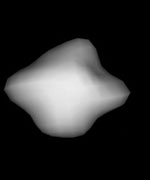
Image credit: ESA
The Hubble Space Telescope has been making detailed observations of Comet 67P/Churyumov-Gerasimenko – the new target for the European Space Agency’s Rosetta mission. The data from Hubble has helped the ESA make precise measurements of the comet’s shape, size and spin-rate so they can fine-tune Rosetta’s flight. If all goes well, Rosetta will launch on February 26, 2004, and then take 10 years to reach the comet. It will orbit the comet and then drop a scientific package onto the surface which should provide scientists with plenty of new data.
Results from the NASA/ESA Hubble Space Telescope have played a major role in preparing ESA?s ambitious Rosetta mission for its new target, comet 67P/Churyumov-Gerasimenko.
Hubble has been used to make precise measurements of the size, shape and rotational period of the comet. Information that is essential if Rosetta is to rendezvous with the comet and then drop down a probe, something never before attempted and yet a major step towards elucidating the origins of the solar system.
Observations made by Hubble in March this year revealed that comet 67P/Churyumov-Gerasimenko (67P/C-G) is approximately five by three kilometres in size and shaped like a rugby ball. ESA mission scientists were concerned about the exact size of the solid nucleus, which is needed to adapt the mission to the comet?s gravity.
“Although 67P/C-G is roughly three times larger than the original Rosetta target, its highly elongated shape should make landing on its nucleus feasible, now that measures are in place to adapt the lander package to the new scenario,” says Dr Philippe Lamy of the Laboratoire d’Astronomie Spatiale in France, who is presenting the Hubble results on comet 67P/C-G today at the annual meeting of the Division for Planetary Sciences of the American Astronomical Society in California, USA.
Mission scientists began looking for an alternative target when the Rosetta mission’s launch date was postponed. The delay meant that the original target comet, 46P/Wirtanen, was no longer easily reachable. But scientists did not have enough information on the back-up comet, 67P/C-G, and sought data from the largest telescopes.
Using a technique developed over the past decade by Philippe Lamy, Imre Toth (Konkoly Observatory, Hungary), and Harold Weaver (Johns Hopkins University Applied Physics Laboratory, Laurel, USA), the team snapped 61 Hubble images of comet 67P/C-G over a period of 21 hours on 11 and 12 March. Hubble’s Wide Field Planetary Camera 2 isolated the comet’s nucleus from the coma, the diffuse gas surrounding the nucleus, quickly providing the figures required. The telescope showed that the nucleus is ellipsoidal and measured its rotation rate at approximately 12 hours.
Rosetta’s launch is currently planned for February 2004, with a rendezvous with the comet about 10 years later.
Original Source: ESA News Release
Shuttles Will Return to Flight in March
NASA representatives met with the media on Monday and announced that the space shuttle would begin operations again some time between March 11 and April 6. Several safety changes are going to be made before the first shuttle, Atlantis, launches to visit the International Space Station: the bipod ramp (which shed foam on the Columbia launch) will be redesigned, and launch windows will only be in the day so cameras can track the launch. Perhaps the biggest changes, however, will come from NASA’s attempts to change its culture to improve safety. “We will be safety driven, not schedule driven.”
Three Views of Saturn
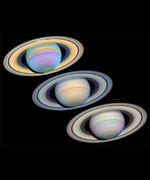
Image credit: Hubble
The planet Saturn reached its maximum tilt towards the Earth last Spring, and astronomers took advantage of the situation to image the ringed planet in three wavelengths of light using the Hubble Space Telescope: ultraviolet, visible, and infrared. Saturn tilts at an angle of 26-degrees and experiences seasons in its hemispheres like the Earth as it travels around the Sun; its orbit takes nearly 30 years. Particles in Saturn’s atmosphere reflect different wavelights of light differently, so the different images can help fill in pieces of missing information.
This is a series of images of Saturn, as seen at many different wavelengths, when the planet’s rings were at a maximum tilt of 26 degrees toward Earth. Saturn experiences seasonal tilts away from and toward the Sun, much the same way Earth does. This happens over the course of its 29.5-year orbit. This means that approximately every 30 years, Earth observers can catch their best glimpse of Saturn’s South Pole and the southern side of the planet’s rings. Between March and April 2003, researchers took full advantage to study the gas giant at maximum tilt. They used NASA’s Hubble Space Telescope to capture detailed images of Saturn’s Southern Hemisphere and the southern face of its rings.
The telescope’s Wide Field Planetary Camera 2 used 30 filters to snap these images on March 7, 2003. The filters span a range of wavelengths. “The set of 30 selected filters may be the best spectral coverage of Saturn observations ever obtained,” says planetary researcher Erich Karkoschka of the University of Arizona. Various wavelengths of light allow researchers to see important characteristics of Saturn’s atmosphere. Particles in Saturn’s atmosphere reflect different wavelengths of light in discrete ways, causing some bands of gas in the atmosphere to stand out vividly in an image, while other areas will be very dark or dull. One image cannot stand by itself because one feature may have several interpretations. In fact, only by combining and comparing these different images, in a set such as this one, can researchers interpret the data and better understand the planet.
By examining the hazes and clouds present in these images, researchers can learn about the dynamics of Saturn’s atmosphere. Scientists gain insight into the structure and gaseous composition of Saturn’s clouds via inspection of images such as these taken by the Hubble telescope. Over several wavelength bands, from infrared to ultraviolet, these images reveal the properties and sizes of aerosols in Saturn’s gaseous makeup. For example, smaller aerosols are visible only in the ultraviolet image, because they do not scatter or absorb visible or infrared light, which have longer wavelengths. By determining the characteristics of the atmosphere’s constituents, researchers can describe the dynamics of cloud formation. At certain visible and infrared wavelengths, light absorption by methane gas blocks all but the uppermost layers of Saturn’s atmosphere, which helps researchers discern clouds at different altitudes. In addition, when compared with images of Saturn from seasons past (1991 and 1995), this view of the planet also offers scientists a better comprehension of Saturn’s seasonal changes.
Original Source: Hubble News Release
